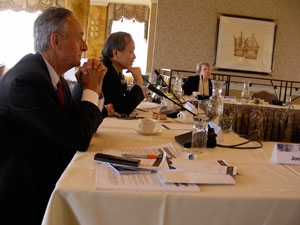
Environmental Factor, May 2008, National Institute of Environmental Health Sciences
Gene, Environment and Disease Panel Meets in San Francisco
By Eddy Ball
May 2008




At an NIEHS-sponsored international meeting held March 27 – 28 in San Francisco, a panel of American and Japanese environmental health experts explored gene-environment-disease interactions with a workshop titled “Oxidative Injury as a Central Mechanism of Disease.” The annual meeting was part of the U.S.–Japan Cooperative Medical Science Program (USJCMSP), one of the longest running bilateral programs in NIH history. The meeting was funded as a result of NIEHS successfully competing for an opportunity grant from the Department of Health and Human Services.
One of nine USJCMSP panels, the Gene, Environment and Disease (GED) Panel was formed in 1972 as the Environmental Mutagenesis and Carcinogenesis Panel with NIEHS scientist Fred de Serres, Ph.D., serving as American chair (see text box). In 2001 and 2007, the USJCMSP Joint Committee approved name changes for the panel. This year’s meeting was the first involving a reconstituted GED panel made up of all new members for the US Japan Panel.
Representing NIEHS at the meeting were William Martin, M.D., NIEHS associate director and secretariat for the GED Panel and extramural grantees, including Professor Andre Nel, M.B.Ch.B., Ph.D., of the University of Southern California. Nel and with Steve Kleeberger, Ph.D., chief of the Laboratory of Respiratory Biology, served as co-chairs of the Oxidative Stress scientific sessions on the second day of the workshop.
As Martin explained, reconstituting the panel “was an effort to expand our successes of the past, which were focused primarily on mutagenesis and carcinogenesis, to now include the role of gene-environment interactions in a variety of human diseases.” Because this was the first year of the new panel, Martin added, “Part of the meeting was really an introduction of the [American and Japanese] scientists to each other… and looking at how we want to guide the mission of the panel over the next several years.”
With its responsibility for overseeing seven of the USJCMSP panels and its central administrative role, the National Institute of Allergy and Infectious Disease (NIAID) also participates as an observer at the GED Panel. The institute was represented at the meeting by Senior International Research Advisor Karl Western, M.D., D.T.PH., of the NIAID Office of Global Research, who presented a history of the panel on the first day of the meeting.
Martin described the second day of the meeting as “an absolutely outstanding scientific workshop focused on the role of gene-environment interactions related to oxidant injury and disease mechanisms.” Along with a talk by Nel on cardio-respiratory disease, there were presentations by other NIEHS grantees including Aron Fisher, M.D., director of the Institute for Environmental Medicine at the University of Pennsylvania; John Hayes, Ph.D., of the University of Dundee in Scotland; and Tom Kensler, Ph.D., of Johns Hopkins University’s Bloomberg School of Public Health.
“I see this panel as a real opportunity for NIEHS to develop new research collaborations and training programs involving extramural scientists and Japanese investigators,” Martin said. “We will have a summary that will soon be available,” he continued, “and we are in the discussion phase about publishing some of the scientific papers from the workshop.”
The USJCMSP was founded as a result of a Joint Communiqué issued in January 1965 by President Lyndon B. Johnson and Japanese Prime Minister Eisaku Sato affirming their mutual support for improving the health and well-being of the people of Asia. Meetings of the nine USJCMSP panels are held each year in Pacific Rim countries. The primary U.S. government participants in the program are NIAID, NIEHS, the National Institute of Diabetes and Digestive and Kidney Disease, which also oversees a panel, and the United States Department of State.
Over the past 43 years, the program’s initial focus on the major communicable diseases of the sixties — cholera, leprosy, parasitic diseases, tuberculosis and viral disease — has been expanded to include additional global health concerns. Malnutrition was included in 1966, and six years later NIEHS became involved when the program added environmental mutagenesis and carcinogenesis. Since then the program has expanded to include hepatitis, immunology, AIDS and acute respiratory infections.
Fred de Serres: A Pioneer in NIEHS Global Environmental Health
In 1972, geneticist Fred de Serres, Ph.D., was serving as chief of the NIEHS Environmental Mutagenesis Branch when he was appointed American chair of the new USJCMSP Environmental Mutagenesis and Carcinogenesis Panel. The panel had been proposed by Takashi Sugimura, Ph.D., who was then director of the National Cancer Center Research Institute in Tokyo, and David Rall, M.D., Ph.D., then director of NIEHS. de Serres chaired the debut meeting of the panel in Tokyo that year and served in that role until 1987.
de Serres’ respect for Japanese culture, as well as his scientific knowledge and commitment to Global Environmental Health, was instrumental in the successes of the panel. In 1999, his contributions were recognized by Sugimura and another de Serres colleague, Taijiro Matsushima, Ph.D., in a paper published in Mutation Research. Their retrospective praised the chairman for his “unflagging efforts to promote collaboration between two countries.”
Sugimura and Matsushima described de Serres as “very enthusiastic and efficient in introducing the achievements of Japanese scientists to the US community…, [while also] acting as a conduct for rapid transfer of advances in knowledge and technology in the US to Japanese.”
de Serres, who is semi-retired, continues to write and work from his home in Chapel Hill, N.C. He was profiled in the January 2007 issue (http://www.niehs.nih.gov/news/newsletter/2007/2007jan.pdf) of the Environmental Factor.
Citation: Sugimura T, Matsushima T. 1999. Recollection: Dr. Frederick J. de Serres and the environmental mutagenesis and carcinogenesis panel established under the auspices of the US-Japan Cooperative Medical Science Program. Mutat Res 437:83-87.
"Arizona..." - previous story ![]()
![]() next story - "Meeting Explores..."
next story - "Meeting Explores..."
May 2008 Cover Page



